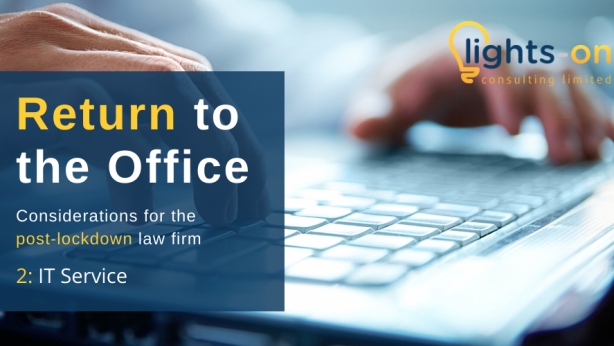In the previous Return to the Office article we focused on the people and workplace aspects of exit from lockdown. In this piece, Stephen Brown discusses what implications the exit from lockdown may have on IT service. Service can mean many things within a law firm, but we cover the IT service desk, 2nd line support and service from IT suppliers, and we touch on the IT impact of service to clients.
This paper aims to provide some food for thought and discussion points for law firms and their IT teams in planning the IT Service aspects of a return to office-based working.
Practical, physical return to the office
As restrictions are lifted, many factors will come into play and affect firms emerging from solely (or near solely) remote working.

IT Service Team – the IT Service Team must now move from solely 1st line telephone / remote screen takeover support to a blend including 2nd line hands-on support. IT teams will have to support the ‘bi-modal’ law firm (a mix of in-office and home-based workers) either for a transition period or, if the law firm seizes an opportunity, forever. Some of the effects on a law firm’s IT Service Desk will be obvious but prepare for others to be more leftfield.
Service from suppliers – your suppliers have been affected in similar ways to you. How will their position and their policies affect your support and the support you give your internal customers?
Service to clients – the return of face-to-face meetings will take some time and the use of video conferencing is likely to continue. What will be the new demands on IT as a result of this?
Post-lockdown considerations for the IT Service Team
Managing teams based across a hybrid of locations – with the inevitability of staggering the return to the office there will be a mixture of people working in the office and at home, possibly with caring and home-schooling responsibilities. This has implications on the IT Service Team, and an alignment of the technologies used to simplify support is likely to be necessary. For example, one law firm rolled out “what it had”, resulting in an old Citrix set-up that was due for retirement being used for longer, a new Citrix set-up launch being brought forward before it was ready, and various flavours of VPN being used. This worked well for “emergency service” but now alignment may be required to simplify use, training and support. Service desks that have a flexible 1st/2nd line arrangement may struggle to deal with remote support and demand from returning staff, with physical visits required to re-install equipment that people have brought back into the office. An understanding of the return to the office schedule and likely work impact is important.
2 metre rule remaining – leaving a 2 metre rule in place when lifting travel restrictions may, for some firms, require a complete re-configuration of office space and a loss of up to 75% of space initially. How will this be done and what is the impact on IT? Getting this right and putting in processes to manage it will take time, so start now.
- Face to face support – physical end-user visits will require safety procedures, such as to clean equipment after contact.
- Importantly, you will need to review whether your staff are comfortable carrying out hands-on 2nd line work and adjust workloads accordingly. The spectrum of your team members’ attitude to risk will be very broad and you are unlikely to be able to mandate any particular work if it involves increased (or perceived increased) risk. An understanding of your staff’s views will at least size the problem before the demand is upon you.
Hot Desking – for now, this is against government recommendations and so those forward-looking firms that have implemented hot desking to maximise their floor plate flexibility may have to put in place processes and possibly technology to ensure that desks are only used by one individual, which clearly is a retrograde step to office flexibility.
2nd Line “Hands on” Support – Difficulties are likely to result from hands-on IT work where recipients of IT support struggle to keep 2 metres from the IT person and from all their colleagues! Some thought into a process in a similar vein to how shops have managed may be required if volumes of returners increase and social distancing rules remain.
Service Hours – with a mix of in-office and home working set to continue, how will you support a workforce that may be running on flexible hours, when your own staff may not have returned to the office for various personal reasons? An early assessment of likely scenarios is advised to explore whether your IT Service Desk can cope with 1st line support and, importantly, the re-growth of 2nd line service needs. Those service desk and 2nd line staff who have not returned to the office will not have experience of what the new office layout is like, so you may consider peer briefings to keep the team informed of changing layouts or clear division of roles between in-office and home working support.
Incidents versus Service Requests – the service team may have been focussed solely on fixing incidents. As the firm adjusts to the new normal it is important to use the data from the firm’s Service Desk to ensure resources are delivering the biggest bang for their buck. Be mindful of service requests especially movers, leavers, and starters. Collection of and re-purposing of equipment will now require new processes.
 Equipment “Re-Set” – it is obvious, but “emergency” changes may have been made to equipment for home use that either needs to be reset (e.g. printers changed to PDF drivers or VPN / IP address or host file changes etc). Have the list ready and people trained to carry out the changes and consider that the equipment may have to go back out again so try to streamline the process.
Equipment “Re-Set” – it is obvious, but “emergency” changes may have been made to equipment for home use that either needs to be reset (e.g. printers changed to PDF drivers or VPN / IP address or host file changes etc). Have the list ready and people trained to carry out the changes and consider that the equipment may have to go back out again so try to streamline the process.
Changes – the firm and the IT department will be adjusting to the new normal. Guidance documents and process adjustments may have been released regularly. What processes to “re-induct” staff as they return from furlough are being put in place?
Some considerations for the service from IT suppliers
Re-start testing – during the lockdown, with everyone working at home, there will be office equipment that has not been utilised in some time. An advanced physical system health audit and test is recommended.
Supplier agreements – Do your service level agreements provide the guarantees needed to support a business working remotely or in a bi-modal set-up? If we continue remote support for a longer period of time, re-examination of commercial terms may be required. Have your suppliers had to change their delivery methods, for example comms installations requiring additional PPE and health and safety measures.
MFDs and printers – will the printers require any maintenance (e.g. toner changes)? Can this be done in house or do you need the supplier to do it? If the latter, is your provider willing to do so? Best to check now, so you can adhere to any policies your supplier may have put in place.
Environmental initiatives – your lawyers and support staff will have got used – to varying degrees of success – to managing on home-based technology. If you have not already, do you want to move to two screens or wide screens to encourage the continuation of non-printing methods? If you want to do this, how will you service the needs of users with new set-ups at difficult times. This is a rock and a hard place. Leave it in the “too difficult pile” and users will revert to old ways. Address it now and face short-term adverse reaction from users.
Internet – now may be the time to examine your contracts and bills and assess whether your set-up is optimal for supporting as many people coming in via the internet line and going out, given you will be operating with a different blend of in office and home workers.
 Onsite suppliers – are you expecting your suppliers to come on-site? What provisions will you make for them or what policies have they put in place that will affect the service you receive. Have someone review key suppliers and agree any new approaches required
Onsite suppliers – are you expecting your suppliers to come on-site? What provisions will you make for them or what policies have they put in place that will affect the service you receive. Have someone review key suppliers and agree any new approaches required
Supplier communications – it is obvious to state but suppliers have gone though similar pains to yourself and may not be ready to support all their clients. Keep your suppliers informed of your firm’s return to the office plans and seek to understand their positions and policies and how these will affect the service you receive.
Brief considerations for IT on the service to clients
Communications and AV – a slow return to face-to-face client meetings is inevitable, but video conferencing will continue and increased use is expected. Allowances made outside the office may evaporate as people expect to use a hybrid of group meetings using “traditional” room AV with other groups or Teams/Zoom users. Is your service desk and 2nd line skilled to provide support on what has moved from an occasional to a main-stream product? Collect all the support calls to date and build a training course for your own staff and for end-users to help build some self sufficiency. Importantly, be very clear about what will work with what, as expectations will be that any VC will work with any VC! Your service desk and 2nd line staff need to know this inside out.
Support skills and responsibility – is your team trained and ready to support a blend of office-based and home-based users? Law firms often have split responsibilities between facilities and IT in this area and so clarity of responsibility will be required to provide effective support.
Safe support practices – you will need to look at how your IT Staff can troubleshoot AV equipment issues, whilst maintaining distancing rules.
Portals – exchange of electronic documents is the norm these days but expect to see an increase in self-help and portal / deal-room requests as clients seek to ensure that future lock-downs will not affect service from their law firms.
The next few weeks and months are likely to be among the busiest and challenging for law firm IT teams. Having safely managed a move to remote working at the start of lockdown in March, they now need to facilitate and support a gradual return to office-based working. Thorough planning, strong supplier relationships and agility will all be key. IT teams with a presence on the senior management team will be well placed as they can help shape and guide decision-making and ensure that their firm can support what is likely to be a hybrid of office and home working over the coming months.

